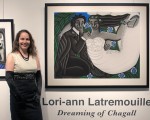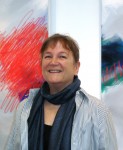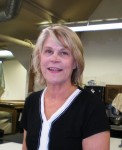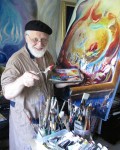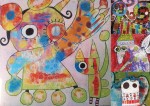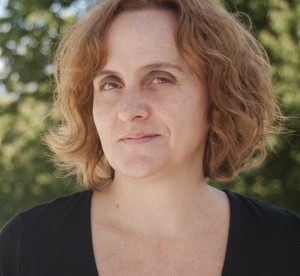Artist Lori-ann Latremouille at the opening of her solo show at the Zack Gallery on Nov. 6. (photo from Lori-ann Latremouille)
Fairy tales do happen in real life. Take, for example, the story of local artist Lori-ann Latremouille. In her case, it was not Prince Charming who changed her life, but rather an art agent, by offering representation to the then 21-year-old unknown artist.
Latremouille left home at 16 to escape an unfortunate family situation. Although she liked painting and drawing at school, she was never exposed to the art world as a child. Later, to make a living, she had to take a job that had nothing to do with the arts. Still, art resided in her heart and wouldn’t be denied. “I knew even then I wanted to be creative, not answer the phones for the rest of my life,” she said in an interview with the Independent. “After a couple years, I quit my job and went to the local library.”
She taught herself art history by reading library books and copying masterpieces from illustrations in those books. She even had a show of her reproductions at that library when she was 18. “I kept asking my friends to pose for me but I couldn’t pay them,” she recalled with a smile. “They soon got tired of it, and so did I.”
Despite the tight budget, she continued teaching herself. “I took a class at Emily Carr once and loved it. At about the same time, I went to an art show opening. I had never been to an art show before. I loved it. I wanted to be involved in an art exhibition.”
After a few setbacks and gallons of perseverance, she managed to open her first solo show when she was 20. “There was another gallery show next door. It opened on the same day as mine, and I got lots of traffic from them,” she recalled. “I even sold a few pieces. Then an agent came to my show. She introduced me to the Heffel Gallery.”
One of the most prominent galleries in Vancouver, Heffel represented Latremouille for several years. Soon after this lucky break, she got an offer from an American dealer: he would buy several of her paintings at once and pay her as much as she needed for her monthly rent and bills so she could paint without financial worries. “He asked me how much I needed a month. I gave him a very modest estimate. I was used to economizing, had lots of practise since I was 16.” She was 21 then and she is still represented by that gallery in Portland. “I was blessed,” she said. “I met the right person at the right time.”
Of course, her talent had something to do with it. Her distinctive style – black and white palette, expressive lines and an occasional splash of solid color – emerged in the very beginning of her artistic career. “One color is like one note in music,” she said. “Black and white make the colors sing.”
Visitors to the Jewish Community Centre of Greater Vancouver can enjoy Latremouille’s visual songs this month, as her solo show Dreaming of Chagall is at the Sidney and Gertrude Zack Gallery until Nov. 30.
“When I started painting,” she said, “I didn’t see any of the great artists [and their work]. I simply liked black and white. Later, one of the prominent collectors of Chagall’s art in San Francisco mentioned the similarities of my works and Chagall’s. She even bought one of my pieces for her collection. I feel honored.… When I first saw Chagall’s paintings and drawings, I fell in love. There is magic in his works. He also liked black and white. One of my favorite quotes of his is, ‘If I create from the heart, nearly everything works; if from the head, almost nothing.’ That’s how I feel, too. My art comes from the heart. There is so much heart in Chagall.”
Latremouille considers herself an apprentice to Chagall, and several of her pictures reflect that self-assessment. Her drawing “Passing the Egg” is a metaphor for such an apprenticeship, a passing of the torch of art. The theme is also apparent in “Master and Apprentice,” while the bride and groom painting “Blue Orchid” clearly drew its inspiration from Chagall’s soaring brides.
Another theme of the show is the unity of human beings with the natural world. In many paintings, the shapes of people and creatures intertwine. There is no border but skin between them. “I always loved nature, loved animals,” she said. “Most forms of animals, birds and fish fit into the shapes of human bodies. We are intrinsically the same. I know that humanity is capable of doing great harm to nature but we are also capable of healing it. People do it all the time, work on restoring the environment, streams and forests. Maybe I’m a bit naïve but I believe it.”
One other pervading theme, running through almost every painting and drawing, is music. Instruments have a place of honor in most images. “I always loved listening to music when I drew. I also wrote poetry. Still do. I wanted to write songs, so I learned to play guitar in my late 20s. I’m an artist first, of course, but I love music and songwriting. I love drawing musical instruments. I think visual art foreshadowed my interest in music.”
Music often feeds her creativity, but anything can give a spark to an idea: a song, a painting by another artist, something she encountered on an outdoor trip. “I sketch all the time,” she said. “Then I look through my sketchbooks, pick a sketch I like, and start a painting. It grows organically, like a visual conversation with the emerging image. I love the creative process, when I see things falling into place, popping up from the two-dimensional lines of the sketch. When people buy a piece, it’s just icing on the cake.”
Even pain and illness have been an inspiration for her art. In 2012, she was diagnosed with breast cancer. After the diagnosis, depression hit her hard, but she fought it. Several of the best pieces in the Zack Gallery show were painted after her recovery from both cancer and depression. “Rescue from Blue” is a visual tale of escaping fear and pain, of flying into the light, while “Dreaming of Chagall” marks a new direction in the artist’s development. The painting is full of joy and more colorful than any other in the exhibition.
Olga Livshin is a Vancouver freelance writer. She can be reached at olgagodim@gmail.com.

